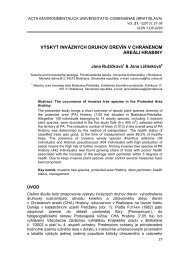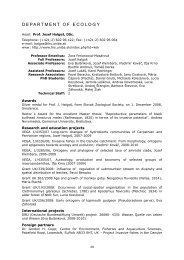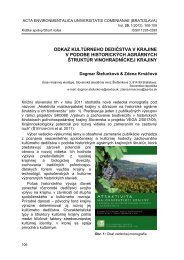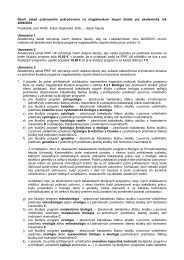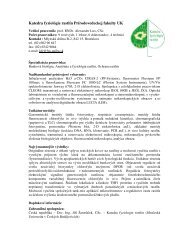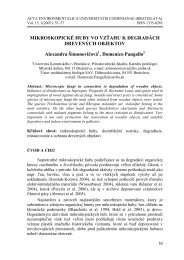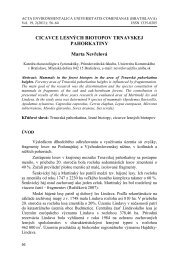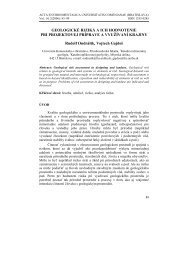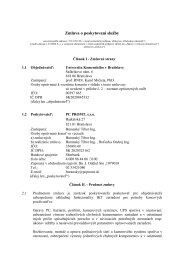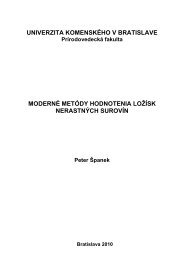UNIVERZITA KOMENSKÉHO V BRATISLAVE VZÁCNOPRVKOVÁ ...
UNIVERZITA KOMENSKÉHO V BRATISLAVE VZÁCNOPRVKOVÁ ...
UNIVERZITA KOMENSKÉHO V BRATISLAVE VZÁCNOPRVKOVÁ ...
You also want an ePaper? Increase the reach of your titles
YUMPU automatically turns print PDFs into web optimized ePapers that Google loves.
and 0.73-0.86 (Fw I); Mn/(Mn+Fe) = 0.32-0.49 (Ct I), 0.06-0.10 (Ft I) and 0.33-0.41 (Fw<br />
I).<br />
The second generation is represented by ferrocolumbite to ferrotantalite (Ct II) in<br />
fine-grained saccharoidal albite zone and also by replacement zones of ferrotantalite II in<br />
ferrotantalite I. To the second generation belongs also irregular overgrowths of<br />
ferrotapiolite (Ft II) and ferrowodginite (Fw II) on ferrotapiolite I grains. The minerals of<br />
the second generation show decreasing of Ta/(Ta+Nb) ratio in comparison to the first<br />
generation: 0.10-0.60 (Ct II), 0.85-0.87 (Ft II) and 0.73-0.77 (Fw II); Mn/(Mn+Fe) ratio<br />
attains 0.30-0.45 (Ct II), 0.06-0.09 (Ft II) and 0.26-0.37 (Fw II). The second generation is<br />
characterized also by increased content of Ti (up to 1.7 wt.% TiO2 in Ct II, up to 5.4 in Ft<br />
II, up to 5.6 in Fw II). Titanium is introduced by the substitution Ti 4+ + Fe 3+ ↔ (Nb+Ta) 5+<br />
+ (Fe+Mn) 2+ .<br />
The third generation includes fissure fillings, overgrowths and replacement zones<br />
of manganocolumbite and manganotantalite (Ct III), ferrotapiolite (Ft III) and<br />
ferrowodginite (Fw III) on the older Nb-Ta phases (Ct I, Ft I, Fw I, Fw II), in the coarsegrained<br />
unit and also in the saccharoidal albite unit. The third generation displays distinct<br />
increase in Mn/(Mn+Fe) ratio (Ct III: 0.51-0.69, Ft III: 0.11-0.24, Fw III: 0.40-0.41),<br />
Ta/(Ta+Nb) ratio values reach 0.16-0.79 (Ct III), 0.88-0.92 (Ft III) and 0.80-0.81 (Fw III).<br />
The latest Nb-Ta phase identified in the Jezuitské lesy pegmatite is represented by<br />
irregular veinlets and patches of microlite, replacing mainly ferrotapiolite I and<br />
ferotantalite I, rarely also ferrowodginite I, ferrocolumbite II and ferrotapiolite III.<br />
Microlite is distinctly Ta-rich, the Ta/(Ta+Nb) values are evidently higher in microlite<br />
penetrating ferrotapiolite I (0.90-0.97) than it associate with Ct1 (0.82-0.85).<br />
The composition of Nb-Ta minerals shows unusual and complex fractionation<br />
trends within the pegmatite dike. The first generation of Nb-Ta minerals (ferrotantalite I,<br />
ferrotapiolite I and ferrowodginite I) originated during the crystallization of coarsegrained<br />
quartz-microcline-muscovite zone and it is characterized by the relatively high<br />
Ta/(Ta+Nb) ratio. The second generation of Nb-Ta minerals (ferrocolumbite to<br />
ferrotantalite II, ferrotapiolite II, ferrowodginite II) formed during the crystallization of<br />
fine-grained saccharoidal albite zone and it is characterized by the decrease of<br />
Ta/(Ta+Nb) and Mn/(Mn+Fe) ratio. Low Ta/(Ta+Nb) values in ferrocolumbite to<br />
ferrotantalite (Ct II) from the saccharoidal albite unit can be explained by crystallization<br />
from the Ta-depleted, albite-rich melt, which was significantly impoverished in Ta, after<br />
crystallization of Ta-rich phases (ferrotapiolite I, ferrowodginite I). The third generation<br />
132



